Circular Economy for a Sustainable Agri-Food Supply Chain: A Review for Current Trends and Future Pathways
Abstract
:1. Introduction
2. Materials and Methods
2.1. Creation of the Database
2.2. Selection of Papers and Method of Analysis
- Including only articles and reviews written in English: excluding 43 documents in Scopus and 16 in WoS;
- Including only the documents where the full text was available to read: excluding 16 articles from Scopus and 14 from WoS;
- Removal of overlaps between Scopus and WoS: a total of 109 overlapping documents was individuated.
- Including only papers where title and abstract were relevant to the research question: 36 papers from Scopus and 89 papers from WoS.
3. Results
3.1. Measurement of Productivity
3.1.1. Years of Publication
3.1.2. Most Productive Countries
3.1.3. Most Publishing Sources
3.1.4. Research Areas
3.1.5. Most Cited Papers
3.2. Bibliometric Analysis
3.2.1. Co-Occurrence
3.2.2. Co-Authorship
3.2.3. Citation
3.2.4. Bibliographic Coupling
3.2.5. Co-Citation
4. Discussion
5. Conclusions
Author Contributions
Funding
Institutional Review Board Statement
Informed Consent Statement
Data Availability Statement
Acknowledgments
Conflicts of Interest
References
- Jurgilevich, A.; Birge, T.; Kentala-Lehtonen, J.; Korhonen-Kurki, K.; Pietikäinen, J.; Saikku, L.; Schösler, H. Transition towards circular economy in the food system. Sustainability 2016, 8, 69. [Google Scholar] [CrossRef] [Green Version]
- Ellen Macarthur Foundation. Towards a Circular Economy: Business Rationale for an Accelerated Transition. 2015. Available online: https://www.ellenmacarthurfoundation.org/assets/downloads/TCE_Ellen-MacArthur-Foundation_9-Dec-2015.pdf (accessed on 27 April 2021).
- Ghisellini, P.; Cialani, C.; Ulgiati, S. A review on circular economy: The expected transition to a balanced interplay of environmental and economic systems. J. Clean. Prod. 2016, 114, 11–32. [Google Scholar] [CrossRef]
- European Parliament. 2015. Available online: https://www.europarl.europa.eu/news/en/headlines/priorities/circular-economy/20151201STO05603/circular-economy-definition-importance-and-benefits (accessed on 13 May 2021).
- Kirchherr, J.; Reike, D.; Hekkert, M. Conceptualizing the circular economy: An analysis of 114 definitions. Resour. Conserv. Recy 2017, 127, 221–232. [Google Scholar] [CrossRef]
- Geissdoerfer, M.; Savaget, P.; Bocken, N.M.; Hultink, E.J. The Circular Economy—A new sustainability paradigm? J. Clean. Prod. 2017, 143, 757–768. [Google Scholar] [CrossRef] [Green Version]
- Korhonen, J.; Honkasalo, A.; Seppälä, J. Circular economy: The concept and its limitations. Ecol. Econ. 2018, 143, 37–46. [Google Scholar] [CrossRef]
- European Commission. Closing the Loop: An EU Action Plan for the Circular Economy; European Commission: Brussels, Belgium, 2015; Available online: https://eur-lex.europa.eu/resource.html?uri=cellar:8a8ef5e8-99a0-11e5-b3b7-01aa75ed71a1.0012.02/DOC_1&format=PDF (accessed on 27 April 2021).
- European Commission. Report on the Implementation of the Circular Economy Action Plan; European Commission: Brussels, Belgium, 2019; Available online: https://eur-lex.europa.eu/legal-content/EN/TXT/PDF/?uri=CELEX:52019DC0190&from=EN (accessed on 27 April 2021).
- European Commission. Circular Economy Action Plan for a Cleaner and More Competitive Europe; European Commission: Brussels, Belgium, 2020; Available online: https://ec.europa.eu/environment/pdf/circular-economy/new_circular_economy_action_plan.pdf (accessed on 27 April 2021).
- Cristóbal, J.; Castellani, V.; Manfredi, S.; Sala, S. Prioritizing and optimizing sustainable measures for food waste prevention and management. Waste Manag. 2018, 72, 3–16. [Google Scholar] [CrossRef]
- Stenmarck, Å.; Jensen, C.; Quested, T.; Moates, G. Estimates of European Food Waste Levels; IVL Swedish Environmental Research Institute: Stockholm, Sweden, 2016. [Google Scholar]
- Finco, A.; Bentivoglio, D.; Bucci, G. Lessons of Innovation in the Agrifood Sector: Drivers of Innovativeness Performances. Econ. Agro Aliment. Food Econ. 2018, 20, 181–192. [Google Scholar] [CrossRef]
- Eurostat. 2021. Available online: https://ec.europa.eu/eurostat/statistics-explained/index.php?title=Waste_statistics (accessed on 13 May 2021).
- FAO. Global Food Losses and Food Waste. In Extent, Causes and Prevention; FAO: Rome, Italy, 2011. [Google Scholar]
- Parfitt, J.; Barthel, M.; Macnaughton, S. Food waste within food supply chains: Quantification and potential for change to 2050. Philos. Trans. R. Soc. B Biol. Sci. 2010, 365, 3065–3081. [Google Scholar] [CrossRef] [PubMed] [Green Version]
- European Commission. Directive 2008/98/EC of 19 November 2008 on Waste and Repealing Certain Directives; European Commission: Brussels, Belgium, 2008; Available online: https://eur-lex.europa.eu/legal-content/EN/TXT/PDF/?uri=CELEX:32008L0098&from=EN (accessed on 11 May 2021).
- Papargyropoulou, E.; Lozano, R.; Steinberger, J.K.; Wright, N.; Ujang, Z.B. The food waste hierarchy as a framework for the management of food surplus and food waste. J. Clean. Prod. 2014, 76, 106–115. [Google Scholar] [CrossRef]
- Girotto, F.; Alibardi, L.; Cossu, R. Food waste generation and industrial uses: A review. Waste Manag. 2015, 45, 32–41. [Google Scholar] [CrossRef] [PubMed]
- Galanakis, C.M. Recovery of high added-value components from food wastes: Conventional, emerging technologies and commercialized applications. Trends Food Sci. Technol. 2012, 26, 68–87. [Google Scholar] [CrossRef]
- Caruso, G.; Floris, R.; Serangeli, C.; Di Paola, L. Fishery wastes as a yet undiscovered treasure from the sea: Biomolecules sources, extraction methods and valorization. Mar. Drugs 2020, 18, 622. [Google Scholar] [CrossRef] [PubMed]
- Hussain, S.; Jõudu, I.; Bhat, R. Dietary fiber from underutilized plant resources-A positive approach for valorization of fruit and vegetable wastes. Sustainablity 2020, 12, 5401. [Google Scholar] [CrossRef]
- Plainfossé, H.; Trinel, M.; Verger-Dubois, G.; Azoulay, S.; Burger, P.; Fernandez, X. Valorisation of Ribes nigrum L. Pomace, an Agri-Food By-Product to Design a New Cosmetic Active. Cosmetics 2020, 7, 56. [Google Scholar] [CrossRef]
- Osorio, L.L.D.R.; Flórez-López, E.; Grande-Tovar, C.D. The Potential of Selected Agri-Food Loss and Waste to Contribute to a Circular Economy: Applications in the Food, Cosmetic and Pharmaceutical Industries. Molecules 2021, 26, 515. [Google Scholar] [CrossRef]
- Matos, J.S.; Barberino, A.T.M.S.; de Araujo, L.P.; Lôbo, I.P.; de Almeida Neto, J.A. Potentials and Limitations of the Bioconversion of Animal Manure Using Fly Larvae. Waste Biomass Valori. 2020, 12, 3497–3520. [Google Scholar] [CrossRef]
- Derler, H.; Lienhard, A.; Berner, S.; Grasser, M.; Posch, A.; Rehorska, R. Use Them for What They Are Good at: Mealworms in Circular Food Systems. Insects 2021, 12, 40. [Google Scholar] [CrossRef]
- Lahlou, F.-Z.; Mackey, H.R.; Al-Ansari, T. Wastewater reuse for livestock feed irrigation as a sustainable practice: A so-cio-environmental-economic review. J. Clean. Prod. 2021, 294, 126331. [Google Scholar] [CrossRef]
- Renai, L.; Tozzi, F.; Scordo, C.V.; Giordani, E.; Bruzzoniti, M.C.; Fibbi, D.; Mandi, L.; Ouazzani, N.; Del Bubba, M. Productivity and nutritional and nutraceutical value of strawberry fruits (Fragaria x ananassa Duch.) cultivated under irrigation with treated wastewaters. J. Sci. Food Agric. 2021, 101, 1239–1246. [Google Scholar] [CrossRef]
- Vaneeckhaute, C.; Styles, D.; Prade, T.; Adams, P.; Thelin, G.; Rodhe, L.; Gunnarsson, I.; D’Hertefeldt, T. Closing nutrient loops through decentralized anaerobic digestion of organic residues in agricultural regions: A multi-dimensional sustainability assessment. Resour. Conserv. Recycl. 2018, 136, 110–117. [Google Scholar] [CrossRef] [Green Version]
- Rekleitis, G.; Haralambous, K.J.; Loizidou, M.; Aravossis, K. Utilization of agricultural and livestock waste in anaerobic digestion (AD): Applying the biorefinery concept in a circular economy. Energies 2020, 13, 4428. [Google Scholar] [CrossRef]
- Di Bitonto, L.; Reynel-Ávila, H.E.; Mendoza-Castillo, D.I.; Bonilla-Petriciolet, A.; Pastore, C. Residual Mexican biomasses for bioenergy and fine chemical production: Correlation between composition and specific applications. Biomass Convers. Biorefin. 2021, 11, 619–631. [Google Scholar] [CrossRef]
- Camón Luis, E.; Celma, D. Circular Economy. A Review and Bibliometric Analysis. Sustainability 2020, 12, 6381. [Google Scholar] [CrossRef]
- Do, Q.; Ramudhin, A.; Mishra, N.; Wulandhari, I.; Lallwani, C.; Li, D. A systematic review of food loss and waste for the circular economy. In Proceedings of the 24th International Symposium on Logistics on “Supply Chain Networks vs Platforms: Innovations, Challenges and Opportunities”, Würzburg, Germany, 14–17 July 2019; pp. 436–462. [Google Scholar]
- González-Torres, T.; Rodríguez-Sánchez, J.-L.; Pelechano-Barahona, E.; García-Muiña, F.E. A Systematic Review of Research on Sustainability in Mergers and Acquisitions. Sustainability 2020, 12, 513. [Google Scholar] [CrossRef] [Green Version]
- Martinho, V.D.; Mourão, P.R. Circular Economy and Economic Development in the European Union: A Review and Bibliometric Analysis. Sustainability 2020, 12, 7767. [Google Scholar] [CrossRef]
- Van Eck, N.J.; Waltman, L. VOSviewer Manual. 2020. Available online: https://www.vosviewer.com/documentation/Manual_VOSviewer_1.6.16.pdf (accessed on 17 February 2021).
- Hernández-Rosas, F.; Figueroa-Rodríguez, K.A.; García-Pacheco, L.A.; Velasco-Velasco, J.; Sangerman-Jarquín, D.M. Microorganisms and Biological Pest Control: An Analysis Based on a Bibliometric Review. Agronomy 2020, 10, 1808. [Google Scholar] [CrossRef]
- European Commission. Report on the Implementation of the Circular Economy Action Plan; European Commission: Brussels, Belgium, 2017; Available online: https://eur-lex.europa.eu/resource.html?uri=cellar:391fd22b-e3ae-11e6-ad7c-01aa75ed71a1.0001.02/DOC_1&format=PDF (accessed on 12 April 2021).
- Feng, K.; Lam, C.Y. An Overview of Circular Economy in China: How the Current Challenges Shape the Plans for the Future. Chin. Econ. 2021, 1–17. [Google Scholar] [CrossRef]
- Muscio, A.; Sisto, R. Are Agri-Food Systems Really Switching to a Circular Economy Model? Implications for European Research and Innovation Policy. Sustain. J. Rec. 2020, 12, 5554. [Google Scholar] [CrossRef]
- Mirabella, N.; Castellani, V.; Sala, S. Current options for the valorization of food manufacturing waste: A review. J. Clean. Prod. 2014, 65, 28–41. [Google Scholar] [CrossRef] [Green Version]
- Christou, A.; Agüera, A.; Bayona, J.M.; Cytryn, E.; Fotopoulos, V.; Lambropoulou, D.; Manaia, C.M.; Michael, C.; Revitt, M.; Schröder, P. The potential implications of reclaimed wastewater reuse for irrigation on the agricultural environment: The knowns and unknowns of the fate of antibiotics and antibiotic resistant bacteria and resistance genes—A review. Water Res. 2017, 123, 448–467. [Google Scholar] [CrossRef] [Green Version]
- Nizami, A.S.; Rehan, M.; Waqas, M.; Naqvi, M.; Ouda, O.K.M.; Shahzad, K.; Miandad, R.; Khan, M.Z.; Syamsiro, M.; Ismail, I.M.; et al. Waste biorefineries: Enabling circular economies in developing countries. Bioresour. Technol. 2017, 241, 1101–1117. [Google Scholar] [CrossRef]
- Stiles, W.A.V.; Styles, D.; Chapman, S.P.; Esteves, S.; Bywater, A.; Melville, L.; Silkina, A.; Lupatsch, I.; Grünewald, C.F.; Lovitt, R.; et al. Using microalgae in the circular economy to valorise anaerobic digestate: Challenges and opportunities. Bioresour. Technol. 2018, 267, 732–742. [Google Scholar] [CrossRef] [Green Version]
- Markou, G.; Wang, L.; Ye, J.F.; Unc, A. Using agro-industrial wastes for the cultivation of microalgae and duckweeds: Contamination risks and biomass safety concerns. Biotechnol. Adv. 2018, 36, 1238–1254. [Google Scholar] [CrossRef]
- Maina, S.; Kachrimanidou, V.; Koutinas, A. A roadmap towards a circular and sustainable bioeconomy through waste valorization. Curr. Opin. Green Sustain. Chem. 2017, 8, 18–23. [Google Scholar] [CrossRef]
- Grimm, D.; Wösten, H.A.B. Mushroom cultivation in the circular economy. Appl. Microbiol. Biotechnol. 2018, 102, 7795–7803. [Google Scholar] [CrossRef] [PubMed] [Green Version]
- Hamelin, L.; Borzęcka, M.; Kozak, M.; Pudełko, R. A spatial approach to bioeconomy: Quantifying the residual biomass potential in the EU-27. Renew. Sustain. Energy Rev. 2019, 100, 127–142. [Google Scholar] [CrossRef]
- Riding, M.J.; Herbert, B.M.J.; Ricketts, L.; Dodd, I.; Ostle, N.; Semple, K.T. Harmonising conflicts between science, regulation, perception and environmental impact: The case of soil conditioners from bioenergy. Environ. Int. 2015, 75C, 52–67. [Google Scholar] [CrossRef] [PubMed]
- Pagotto, M.; Halog, A. Towards a Circular Economy in Australian Agri-food Industry An Application of Input-Output Oriented Approaches for Analyzing Resource Efficiency and Competitiveness Potential. J. Ind. Ecol. 2015, 20, 1176–1186. [Google Scholar] [CrossRef]
- Zucchella, A.; Previtali, P. Circular business models for sustainable development: A “waste is food” restorative ecosystem. Bus. Strateg. Environ. 2018, 1–12. [Google Scholar] [CrossRef]
- Hamam, M.; Chinnici, G.; Di Vita, G.; Pappalardo, G.; Pecorino, B.; Maesano, G.; D’Amico, M. Circular Economy Models in Agro-Food Systems: A Review. Sustainability 2021, 13, 3453. [Google Scholar] [CrossRef]
- McDowall, W.; Geng, Y.; Huang, B.; Barteková, E.; Bleischwitz, R.; Türkeli, S.; Kemp, R.; Doménech, T. Circular economy policies in China and Europe. J. Ind. Ecol. 2017, 21, 651–661. [Google Scholar] [CrossRef] [Green Version]
- European Commission. The European Green Deal; European Commission: Brussels, Belgium, 2019; Available online: https://eur-lex.europa.eu/resource.html?uri=cellar:b828d165-1c22-11ea-8c1f-01aa75ed71a1.0002.02/DOC_1&format=PDF (accessed on 12 May 2021).
- Condamine, P. Can the European Union Support Waste Prevention without a Proper Legislation? 2020. Available online: https://zerowasteeurope.eu/library/the-case-for-an-integrated-waste-prevention-framework/ (accessed on 10 May 2021).
- Garske, B.; Heyl, K.; Ekardt, F.; Weber, L.M.; Gradzka, W. Challenges of food waste governance: An assessment of European legislation on food waste and recommendations for improvement by economic instruments. Land 2020, 9, 231. [Google Scholar] [CrossRef]
- Union Nations. Transforming Our World: The 2030 Agenda for Sustainable Development. New York, 2015. Available online: http://www.un.org/en/ga/search/view_doc.asp?symbol=A/RES/70/1 (accessed on 27 April 2021).
- European Commission. Farm to Fork Strategy for a Fairy, Healthy and Environmentally-Friendly Food System; European Commission: Brussels, Belgium, 2020; Available online: https://eur-lex.europa.eu/resource.html?uri=cellar:ea0f9f73-9ab2-11ea-9d2d-01aa75ed71a1.0001.02/DOC_1&format=PDF (accessed on 10 May 2021).
- Vecchio, P.D.; Passiante, G.; Barberio, G.; Innella, C. Digital innovation ecosystems for circular economy: The case of ICESP, the Italian circular economy stakeholder platform. Int. J. Innov. Technol. Manag. 2020, 18, 2050053. [Google Scholar] [CrossRef]
- Governement of Netherlands. A Circular Economy in the Netherlands by 2050. 2016. Available online: https://www.government.nl/documents/policy-notes/2016/09/14/a-circular-economy-in-the-netherlands-by-2050 (accessed on 10 May 2021).
- Ministère de la Transition Ecologique. The Anti-Waste Law in the Daily Lives of the French People: What Does that Mean in Practice? 2020. Available online: https://circulareconomy.europa.eu/platform/sites/default/files/anti-waste_law_in_the_daily_lives_of_french_people.pdf (accessed on 10 May 2021).
- Circular Economy Network; ENEA. Rapporto Sull’economia Circolare in Italia. 2020. Available online: https://circulareconomynetwork.it/wp-content/uploads/2020/04/Rapporto-sulleconomia-circolare-in-Italia-2020_r04.pdf (accessed on 27 April 2021).
- Presidenza del Consiglio dei Ministri. Strategia Italiana per la Bioeconomia. 2017. Available online: https://www.agenziacoesione.gov.it/wp-content/uploads/2019/06/bioeconomia_eng.pdf (accessed on 27 April 2021).
- Yong, R. The circular economy in China. J. Mater. Cycles Waste Manag. 2007, 9, 121–129. [Google Scholar] [CrossRef]
- Zhao, Y. China in transition towards a circular economy: From policy to practice. J. Prop. Plan. Environ. Law 2020, 12, 187–202. [Google Scholar] [CrossRef]
- Fidelis, M.; de Moura, C.; Junior, T.K.; Pap, N.; Mattila, P.; Mäkinen, S.; Putnik, P.; Kovačević, D.B.; Tian, Y.; Yang, B. Granato Fruit Seeds as Sources of Bioactive Compounds: Sustainable Production of High Value-Added Ingredients from By-Products within Circular Economy. Molecules 2019, 24, 3854. [Google Scholar] [CrossRef] [PubMed] [Green Version]
- Mirpoor, S.F.; Giosafatto, C.V.L.; Porta, R. Biorefining of seed oil cakes as industrial co-streams for production of innovative bioplastics. A review. Trends Food Sci. Technol. 2021, 109, 259–270. [Google Scholar] [CrossRef]
- Van Keulen, M.; Kirchherr, J. The implementation of the Circular Economy: Barriers and enablers in the coffee value chain. J. Clean. Prod. 2021, 281, 125033. [Google Scholar] [CrossRef]
- Domenech, T.; Bleischwitz, R.; Doranova, A.; Panayotopoulos, D.; Roman, L. Mapping Industrial Symbiosis Development in Europe: Typologies of networks, characteristics, performance and contribution to the Circular Economy. Resour. Conserv. Recycl. 2019, 141, 76–98. [Google Scholar] [CrossRef]
- Frone, D.F.; Frone, S. Circular economy in Romania: An industrial synergy in the agri-food sector. Sci. Pap. Ser. Manag. Econ. Eng. Agric. Rural Dev. 2017, 17, 9. [Google Scholar]
- Vinci, G.; Musarra, M.; Esposito, A.; D’Ascenzo, F. Industrial symbiosis: A sustainable approach for territorial development through the reuse of biomass. In Waste and Waste Management; Organic Waste: Management Strategies, Environmental Impact and Emerging Regulations; Collins, M., Ed.; Nova Science Publishers: New York, NY, USA, 2017; pp. 141–160. [Google Scholar]
- Florencio de Souza, F.; Bigarelli Ferreira, M.; Valélia Saraceni, A.; Mendes Betim, L.; Lucas Pereira, T.; Petter, R.R.H.; Negri Pagani, R.; Mauricio Martins de Resende, L.; Pontes, J.; Moro Piekarski, C. Temporal comparative analysis of industrial symbiosis in a business network: Opportunities of circular economy. Sustainability 2020, 12, 1832. [Google Scholar] [CrossRef] [Green Version]
- Saidani, M.; Yannou, B.; Leroy, Y.; Cluzel, F.; Kendall, A.; Saidani, M.; Yannou, B.; Leroy, Y.; Cluzel, F.; Kendall, A. A taxonomy of circular economy indicators. J. Clean. Prod. 2019, 207, 542–559. [Google Scholar] [CrossRef] [Green Version]
- Eurostat. Available online: https://ec.europa.eu/eurostat/web/circular-economy/indicators (accessed on 27 April 2021).
- Markhali, F.S.; Teixeira, J.A.; Rocha, C.M.R. Olive Tree Leaves—A Source of Valuable Active Compounds. Processes 2020, 8, 1177. [Google Scholar] [CrossRef]
- Barquet, K.; Järnberg, L.; Rosemarin, A.; Macura, B. Identifying barriers and opportunities for a circular phosphorus economy in the Baltic Sea region. Water Res. 2020, 171, 115433. [Google Scholar] [CrossRef] [PubMed]
- Rahimpour Golroudbary, S.; El Wali, M.; Kraslawski, A. Rationality of using phosphorus primary and secondary sources in circular economy: Game-theory-based analysis. Environ. Sci. Policy 2020, 106, 166–176. [Google Scholar] [CrossRef]
- Borrello, M.; Caracciolo, F.; Lombardi, A.; Pascucci, S.; Cembalo, L. Consumers’ Perspective on Circular Economy Strategy for Reducing Food Waste. Sustainability 2017, 9, 141. [Google Scholar] [CrossRef] [Green Version]
- Coderoni, S.; Perito, M.A. Sustainable consumption in the circular economy. An analysis of consumers’ purchase intentions for waste-to-value food. J. Clean. Prod. 2020, 252, 119870. [Google Scholar] [CrossRef]
- Cembalo, L.; Borrello, M.; De Luca, A.I.; Giannoccaro, G.; D’Amico, M. Transitioning agri-food systems into circular economy trajectories. Sustain. Dev. Circ. Econ. 2021, 199–218. [Google Scholar] [CrossRef]
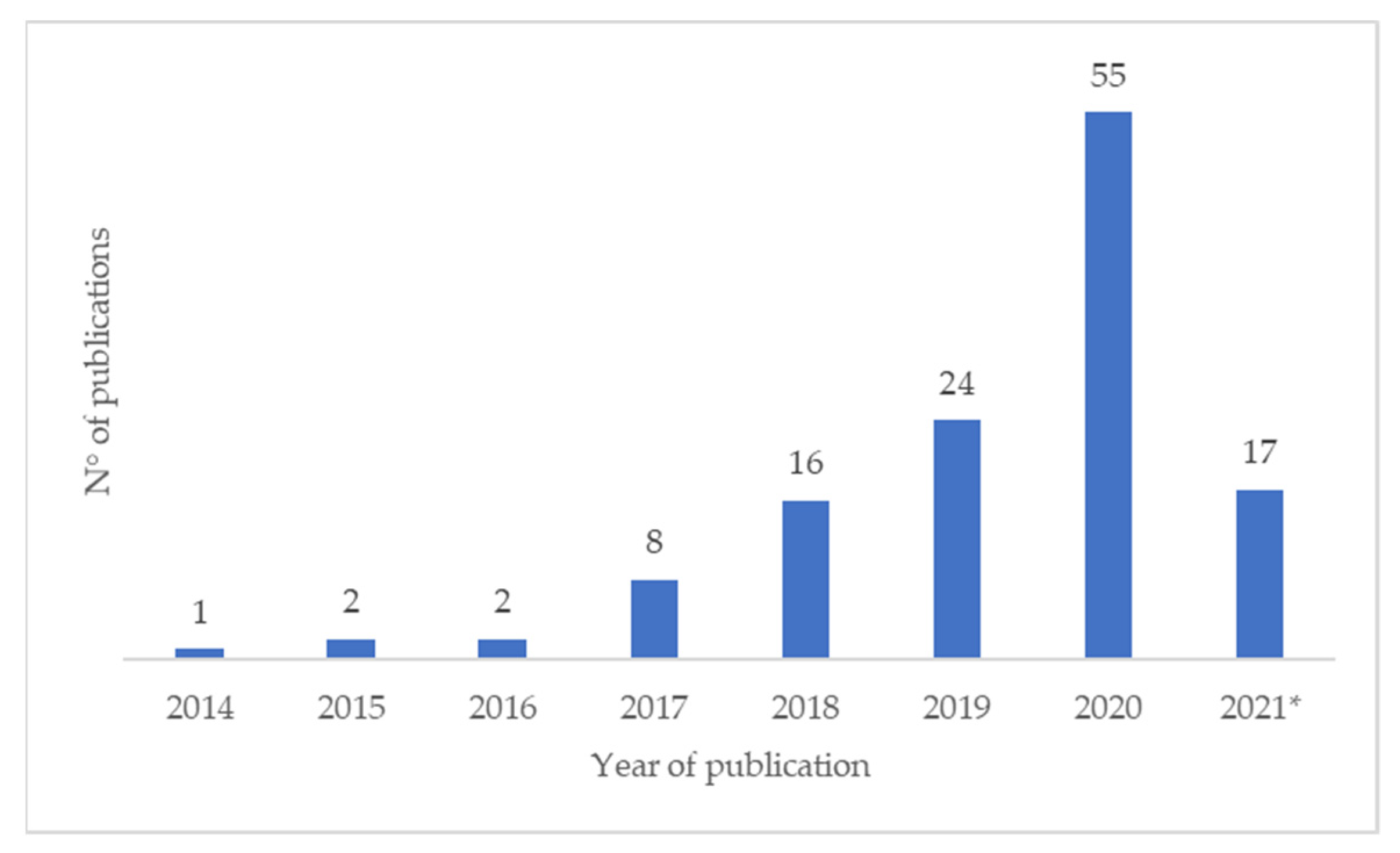
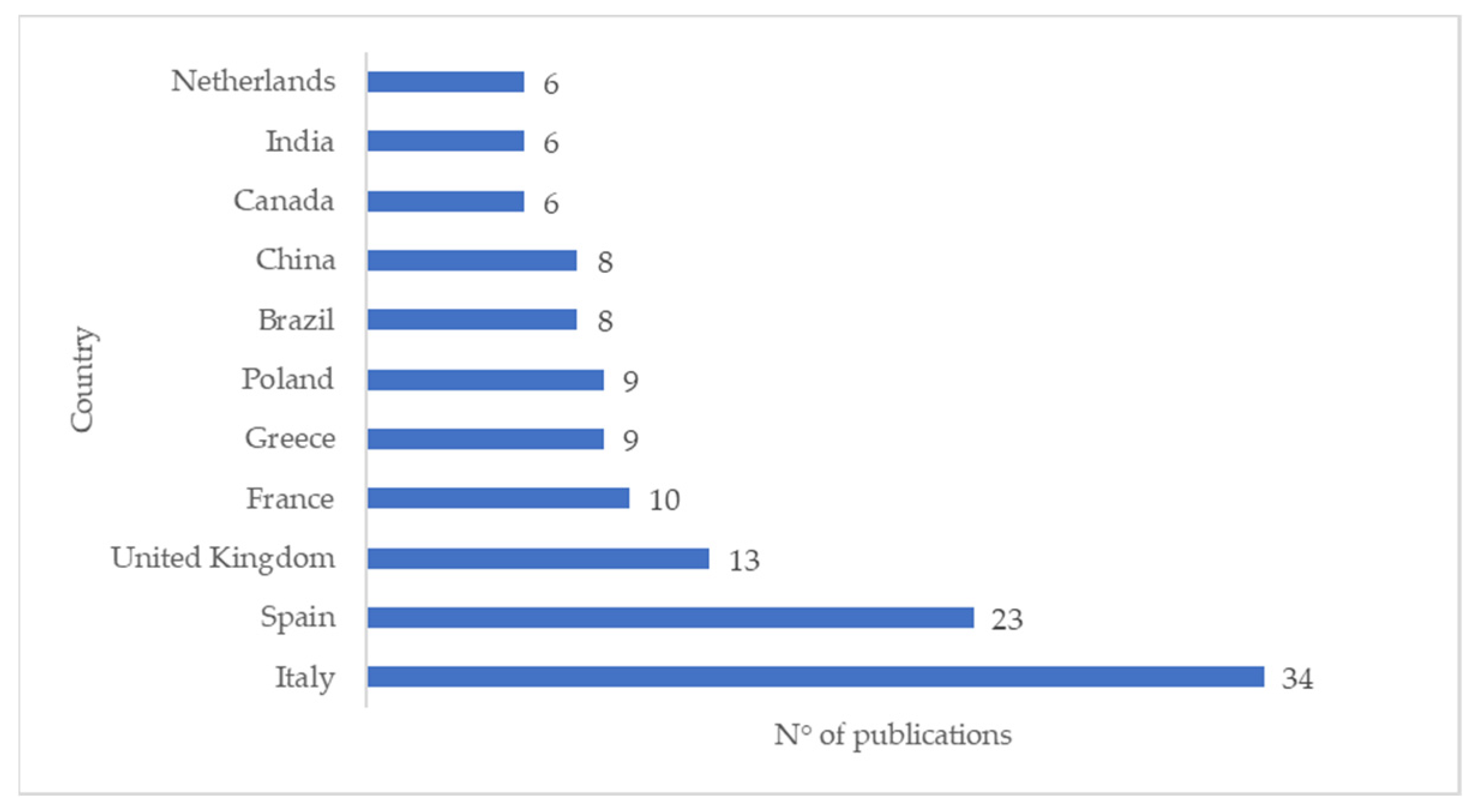

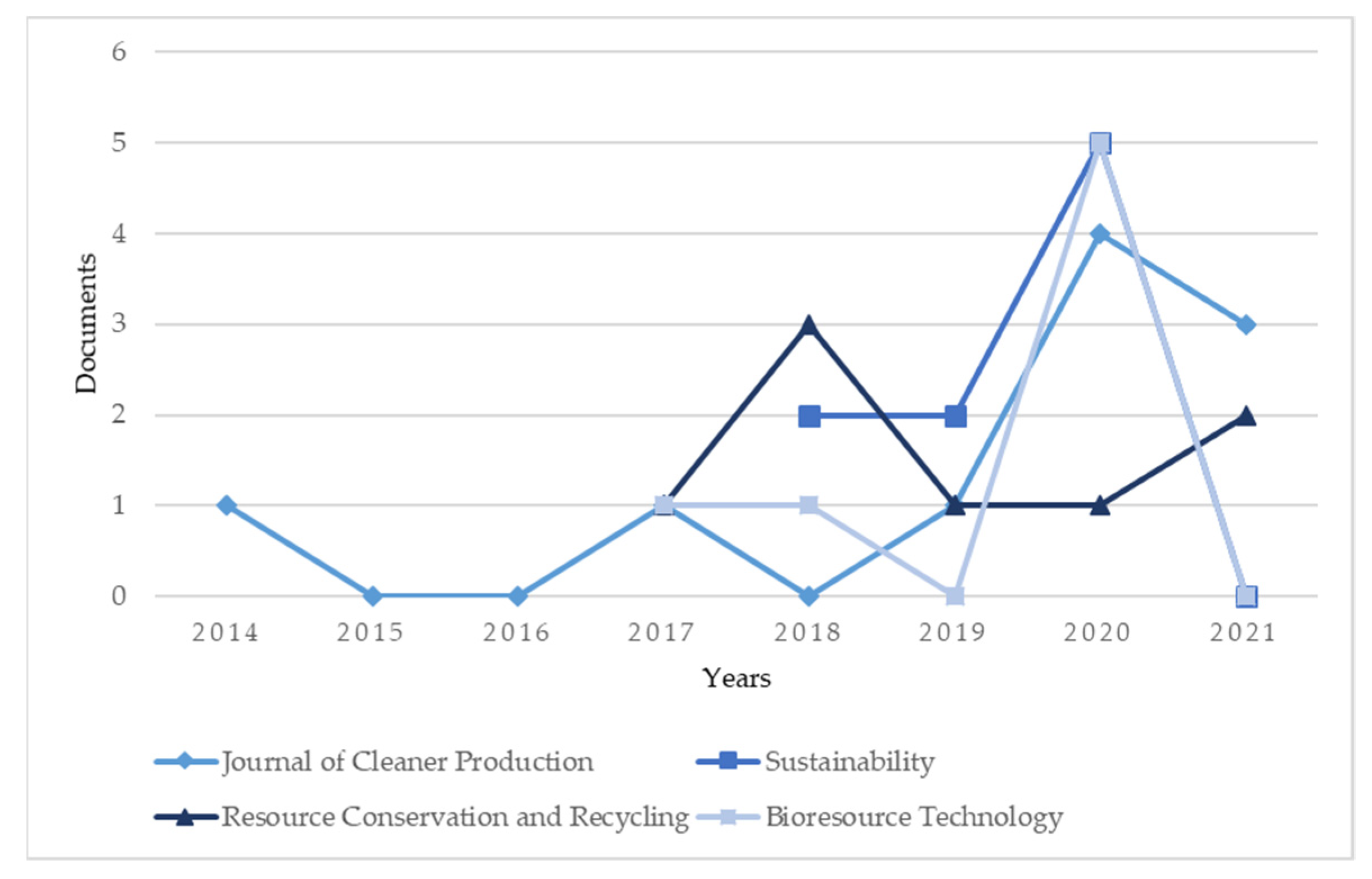
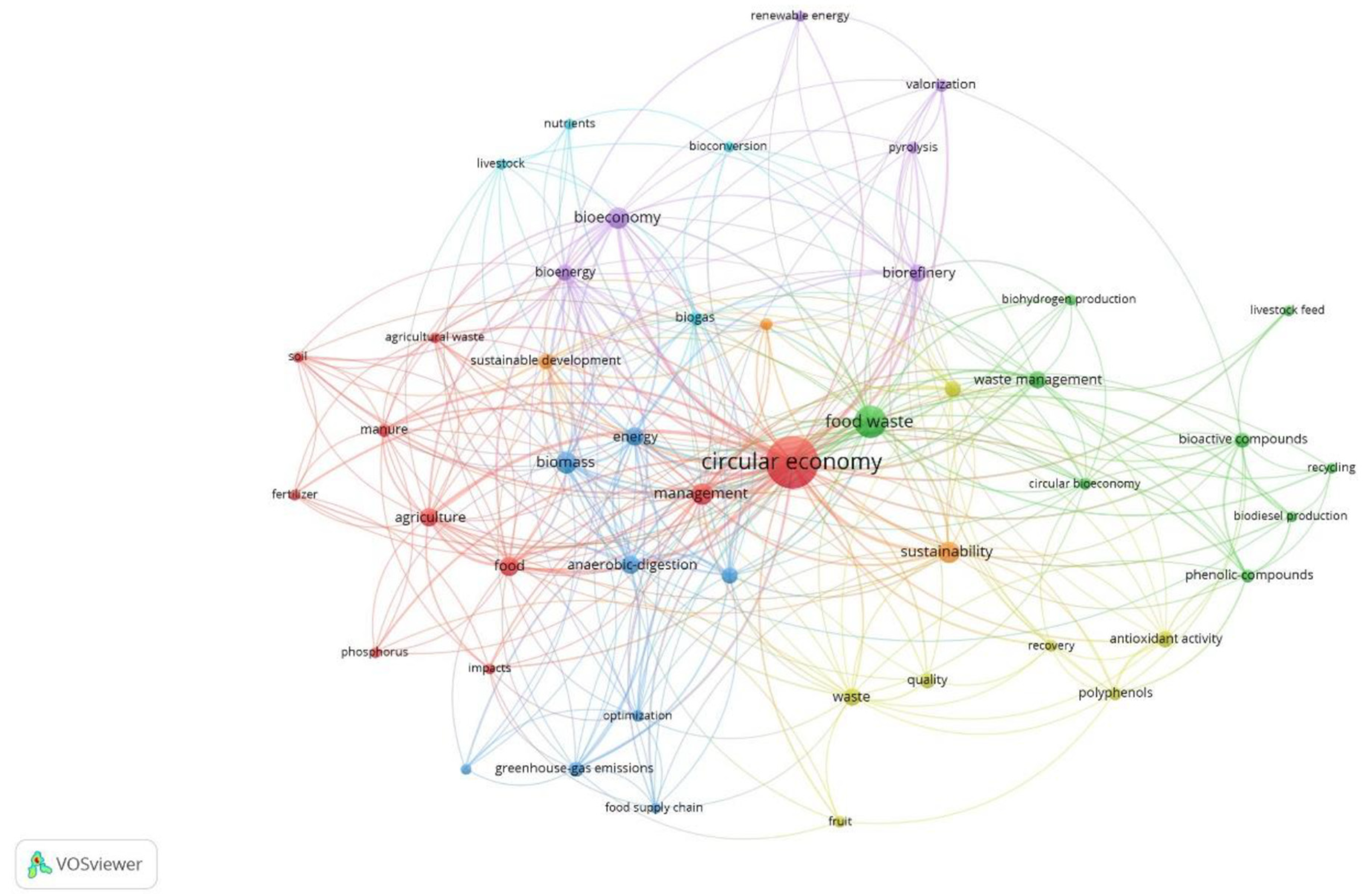

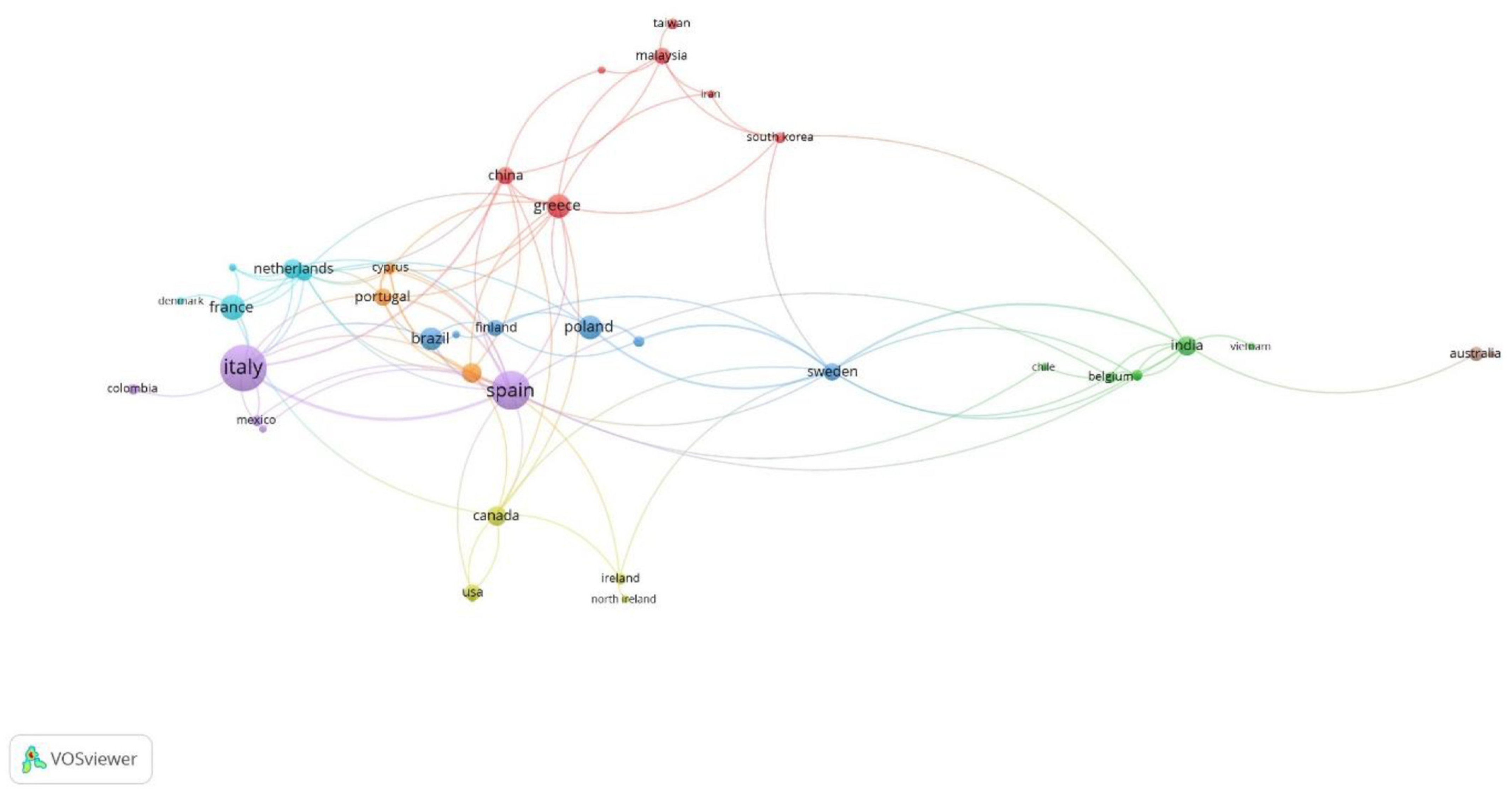
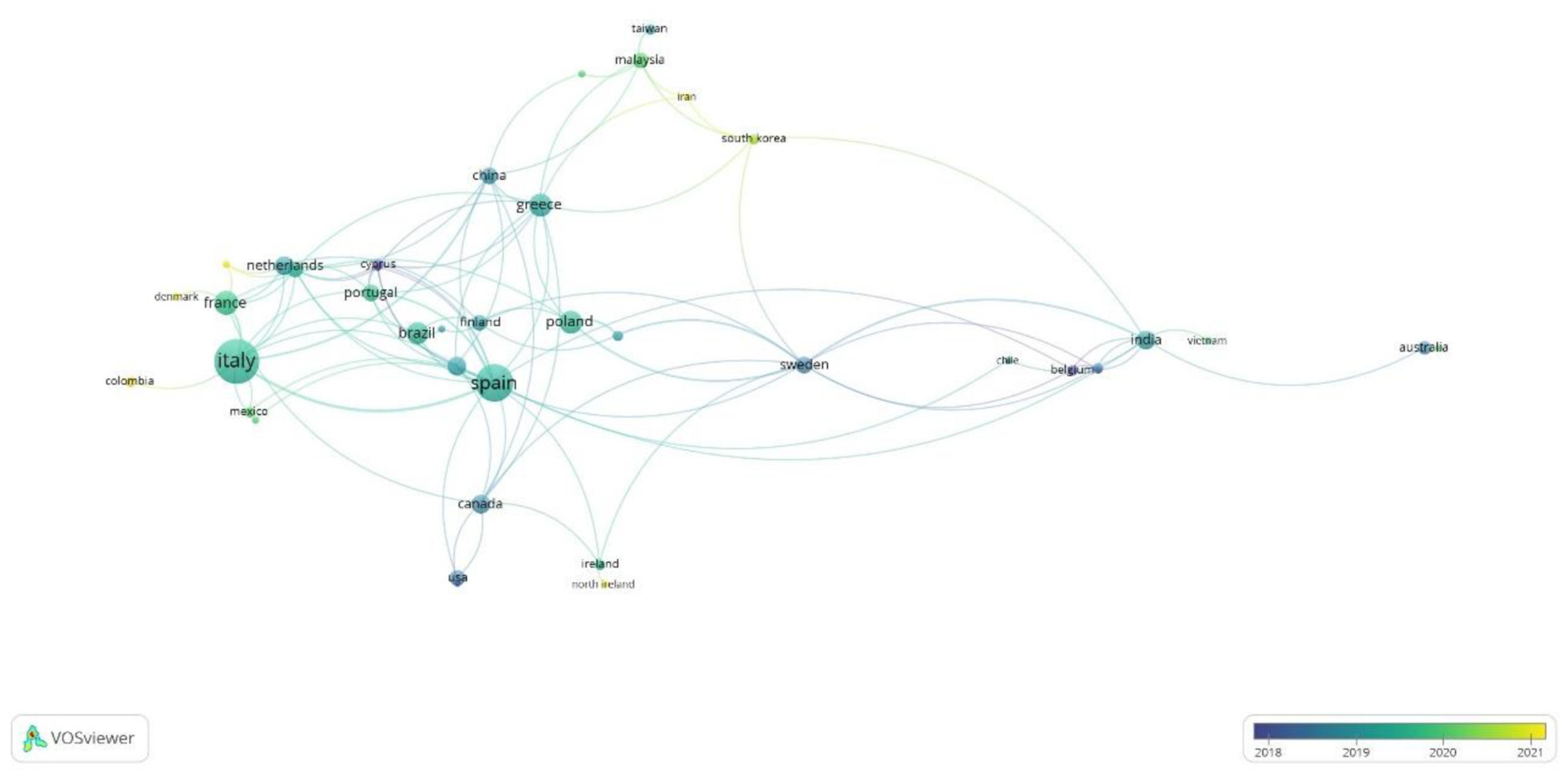
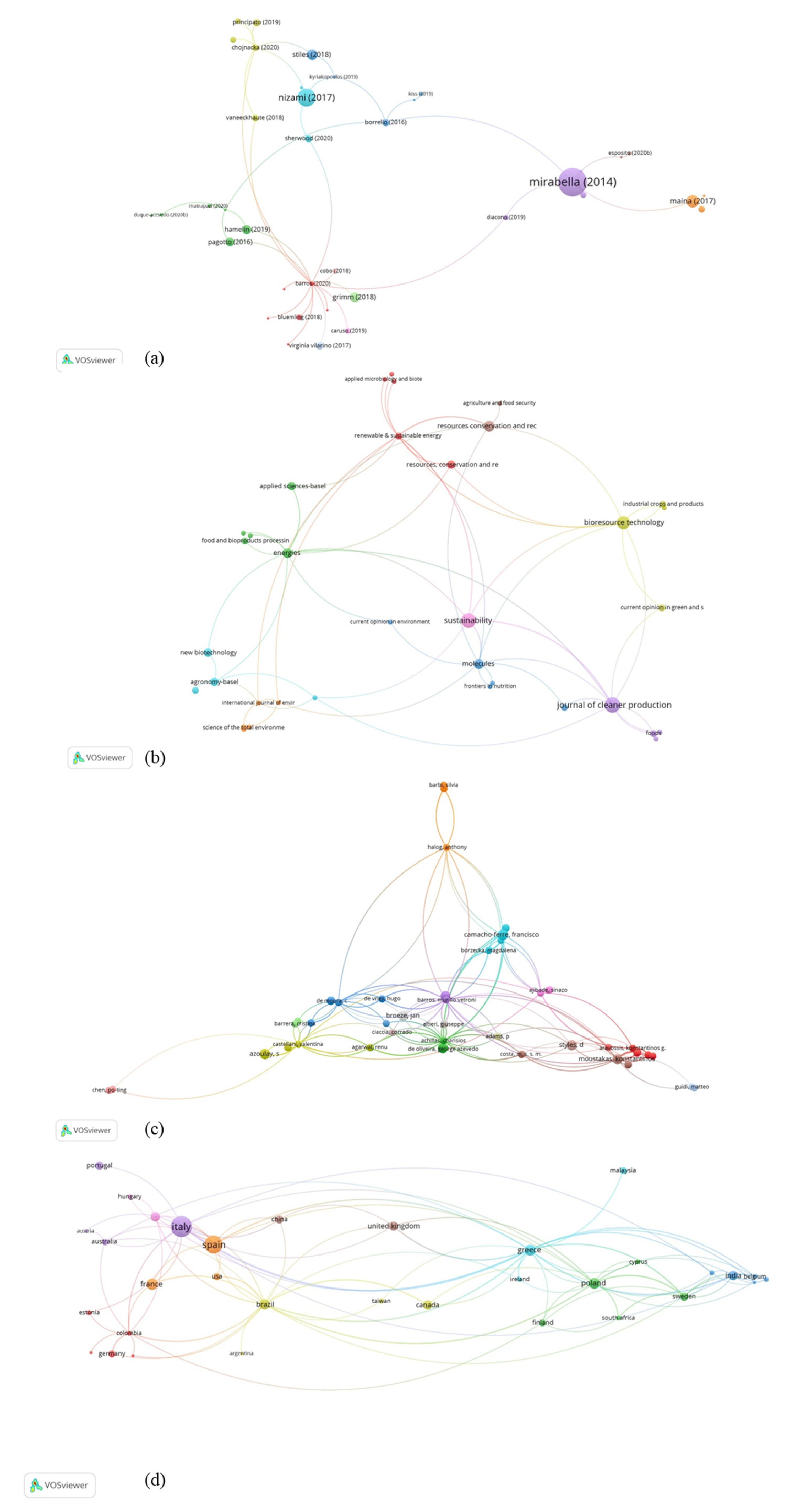

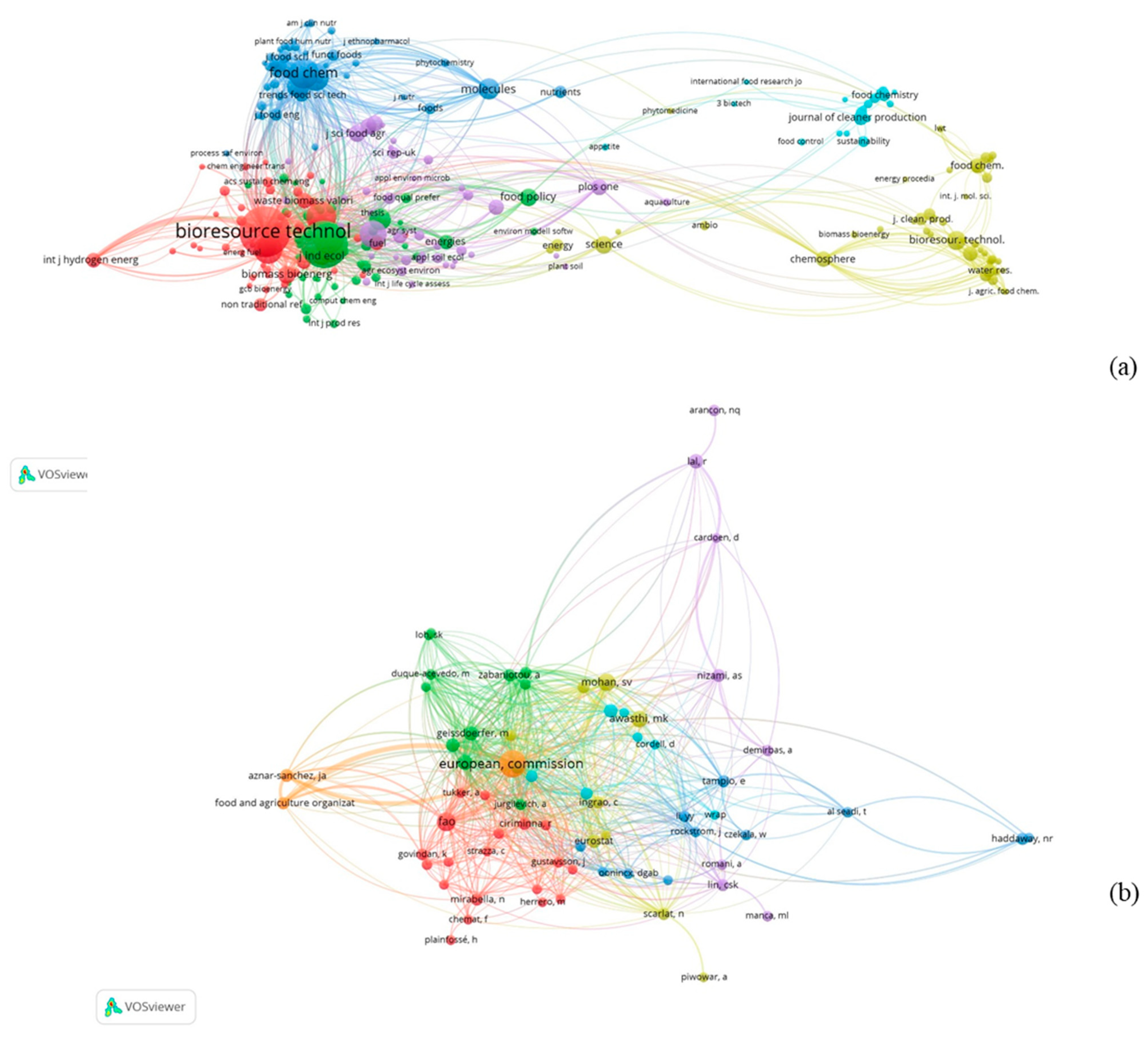
| Search String | Scopus | WoS |
|---|---|---|
| {circular economy} AND ({food waste} OR “by-product”) | 748 | 809 |
| ({circular economy} AND “food” AND (“waste” OR “by-product”)) | 696 | 669 |
| {circular economy} AND “food” AND (“waste” OR “by-product”) AND “agri*” | 224 | 196 |
| Number | Research Area | Number of Documents |
|---|---|---|
| 1 | Environmental Science | 54 |
| 2 | Engineering | 28 |
| 3 | Agriculture | 27 |
| Number | Document Title | Authors | Year of Publication | Citations Received |
|---|---|---|---|---|
| 1 | Current options for the valorisation of food manufacturing waste: a review | Mirabella, N. et al. | 2014 | 386 |
| 2 | The potential implications of reclaimed wastewater reuse for irrigation on the agricultural environment: The knowns and unknowns of the fate of antibiotics and antibiotic resistant bacteria and resistance genes—A review | Christou, A. et al. | 2017 | 164 |
| 3 | Waste biorefineries: Enabling circular economies in developing countries | Nizami, A. et al. | 2017 | 153 |
| 4 | A roadmap towards a circular and sustainable bioeconomy through waste valorization | Maina, S. et al. | 2017 | 74 |
| 5 | Using microalgae in the circular economy to valorise anaerobic digestate: challenges and opportunities | Stiles, W.A.V. et al. | 2018 | 53 |
| 6 | Mushroom cultivation in the circular economy | Grimm, D. et al. | 2018 | 47 |
| 7 | A spatial approach to bioeconomy: Quantifying the residual biomass potential in the EU-27 | Hamelin, L. et al. | 2019 | 40 |
| 8 | Harmonising conflicts between science, regulation, perception and environmental impact: The case of soil conditioners from bioenergy | Riding, M. et al. | 2015 | 37 |
| 9 | Towards a Circular Economy in Australian Agri-food Industry An Application of Input-Output Oriented Approaches for Analyzing Resource Efficiency and Competitiveness Potential | Pagotto, M. and Halog, A. | 2016 | 36 |
| 10 | Using agro-industrial wastes for the cultivation of microalgae and duckweeds: Contamination risks and biomass safety concerns | Markou, G. et al. | 2018 | 34 |
| 11 | Circular business models for sustainable development: A "waste is food" restorative ecosystem | Zucchella, A. and Previtali, P. | 2019 | 34 |
Publisher’s Note: MDPI stays neutral with regard to jurisdictional claims in published maps and institutional affiliations. |
© 2021 by the authors. Licensee MDPI, Basel, Switzerland. This article is an open access article distributed under the terms and conditions of the Creative Commons Attribution (CC BY) license (https://creativecommons.org/licenses/by/4.0/).
Share and Cite
Chiaraluce, G.; Bentivoglio, D.; Finco, A. Circular Economy for a Sustainable Agri-Food Supply Chain: A Review for Current Trends and Future Pathways. Sustainability 2021, 13, 9294. https://doi.org/10.3390/su13169294
Chiaraluce G, Bentivoglio D, Finco A. Circular Economy for a Sustainable Agri-Food Supply Chain: A Review for Current Trends and Future Pathways. Sustainability. 2021; 13(16):9294. https://doi.org/10.3390/su13169294
Chicago/Turabian StyleChiaraluce, Giulia, Deborah Bentivoglio, and Adele Finco. 2021. "Circular Economy for a Sustainable Agri-Food Supply Chain: A Review for Current Trends and Future Pathways" Sustainability 13, no. 16: 9294. https://doi.org/10.3390/su13169294
APA StyleChiaraluce, G., Bentivoglio, D., & Finco, A. (2021). Circular Economy for a Sustainable Agri-Food Supply Chain: A Review for Current Trends and Future Pathways. Sustainability, 13(16), 9294. https://doi.org/10.3390/su13169294








